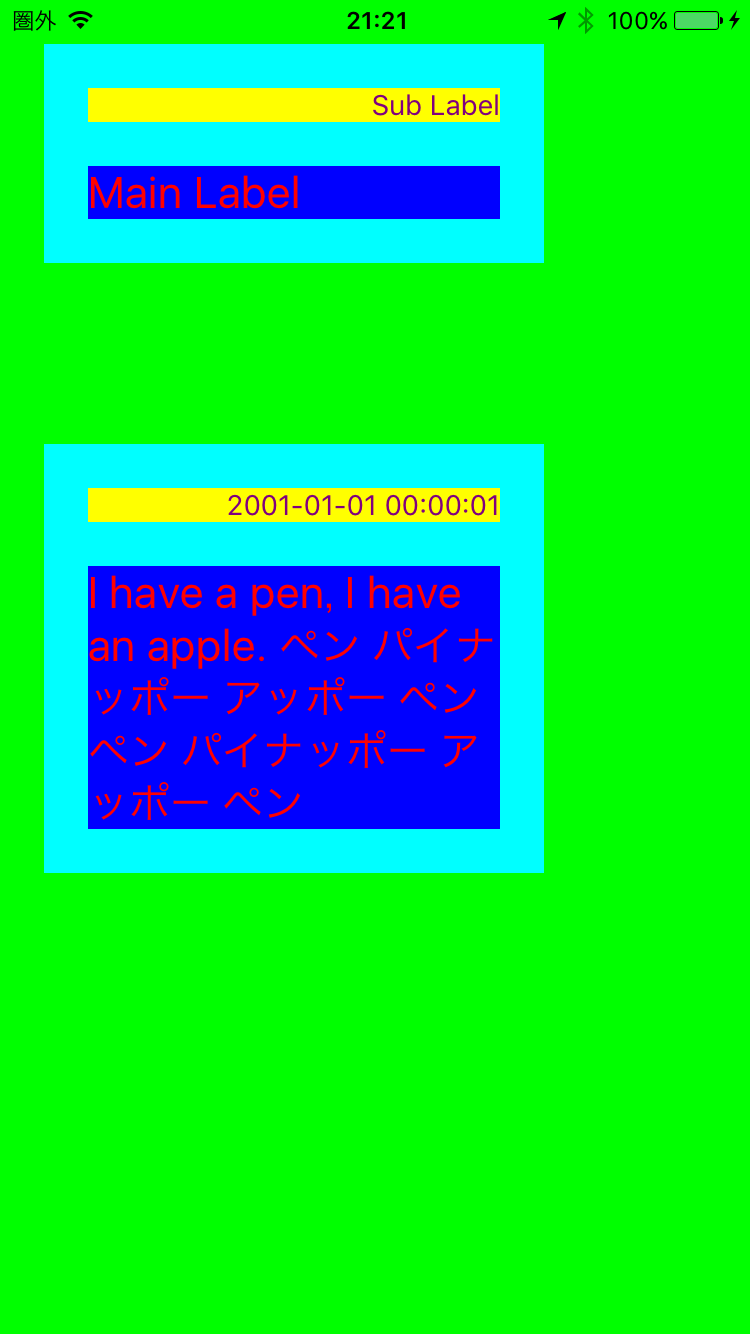iPhone 6 実機にて、実行結果の画面。

Xcode で新規に Single View Application のプロジェクトを作成して、以下のサンプルコードを ViewController.swift に貼り付ければ完成。
//
// ViewController.swift
//
import UIKit
class ViewController: UIViewController {
override func viewDidLoad() {
super.viewDidLoad()
self.view.backgroundColor = .green
_ = ViewController.addContentView(view: self.view, x: 22, y: 22, width: 250, mainLabel: "Main Label", subLabel: "Sub Label")
_ = ViewController.addContentView(view: self.view, x: 22, y: 222, width: 250, mainLabel: "I have a pen, I have an apple. ペン パイナッポー アッポー ペン ペン パイナッポー アッポー ペン", subLabel: "2001-01-01 00:00:01")
}
private static func addContentView(view: UIView, x: CGFloat, y: CGFloat, width: CGFloat, mainLabel: String, subLabel: String) -> UIView {
let frameView = ViewController.addFrameView(parentView: view, x: x, y: y, width: width)
let subLabel = ViewController.addSubLabel(frameView: frameView, text: subLabel)
_ = ViewController.addMainLabel(frameView: frameView, subLabel: subLabel, text: mainLabel)
return frameView
}
private static func addFrameView(parentView: UIView, x: CGFloat, y: CGFloat, width: CGFloat) -> UIView {
// ビューを生成
let frameView = UIView()
frameView.backgroundColor = .cyan
// Autosizing を constraints に適用しない
frameView.translatesAutoresizingMaskIntoConstraints = false
parentView.addSubview(frameView);
// constraints を設定
parentView.addConstraints([
// X座標: x
NSLayoutConstraint(
item: frameView,
attribute: .left,
relatedBy: .equal,
toItem: parentView,
attribute: .left,
multiplier: 1.0,
constant: x),
// Y座標: y
NSLayoutConstraint(
item: frameView,
attribute: .top,
relatedBy: .equal,
toItem: parentView,
attribute: .top,
multiplier: 1.0,
constant: y),
// 横幅: width
NSLayoutConstraint(
item: frameView,
attribute: .width,
relatedBy: .equal,
toItem: nil,
attribute: .width,
multiplier: 1.0,
constant: width),
])
return frameView
}
private static func addSubLabel(frameView: UIView, text: String) -> UILabel {
// ラベルを生成
let subLabel = UILabel()
subLabel.text = text
subLabel.textAlignment = .right
subLabel.font = UIFont.systemFont(ofSize: 14)
subLabel.textColor = .purple
subLabel.backgroundColor = .yellow
// Autosizing を constraints に適用しない
subLabel.translatesAutoresizingMaskIntoConstraints = false
frameView.addSubview(subLabel);
// constraints を設定
frameView.addConstraints([
// 上端: 22ポイント空ける
NSLayoutConstraint(
item: subLabel,
attribute: .top,
relatedBy: .equal,
toItem: frameView,
attribute: .top,
multiplier: 1.0,
constant: 22),
// 左端: 22ポイント空ける
NSLayoutConstraint(
item: subLabel,
attribute: .left,
relatedBy: .equal,
toItem: frameView,
attribute: .left,
multiplier: 1.0,
constant: 22),
// 右端: 22ポイント空ける
NSLayoutConstraint(
item: subLabel,
attribute: .right,
relatedBy: .equal,
toItem: frameView,
attribute: .right,
multiplier: 1.0,
constant: -22),
])
return subLabel
}
private static func addMainLabel(frameView: UIView, subLabel: UIView, text: String) -> UILabel {
// ラベルを生成
let mainLabel = UILabel()
mainLabel.text = text
mainLabel.textAlignment = .left
mainLabel.font = UIFont.systemFont(ofSize: 22)
mainLabel.numberOfLines = 0
mainLabel.textColor = .red
mainLabel.backgroundColor = .blue
// Autosizing を constraints に適用しない
mainLabel.translatesAutoresizingMaskIntoConstraints = false
frameView.addSubview(mainLabel);
// constraints を設定
frameView.addConstraints([
// 上端: 22ポイント空ける
NSLayoutConstraint(
item: mainLabel,
attribute: .top,
relatedBy: .equal,
toItem: subLabel,
attribute: .bottom,
multiplier: 1.0,
constant: 22),
// 左端: 22ポイント空ける
NSLayoutConstraint(
item: mainLabel,
attribute: .left,
relatedBy: .equal,
toItem: frameView,
attribute: .left,
multiplier: 1.0,
constant: 22),
// 右端: 22ポイント空ける
NSLayoutConstraint(
item: mainLabel,
attribute: .right,
relatedBy: .equal,
toItem: frameView,
attribute: .right,
multiplier: 1.0,
constant: -22),
// 下端: 22ポイント空ける
NSLayoutConstraint(
item: mainLabel,
attribute: .bottom,
relatedBy: .equal,
toItem: frameView,
attribute: .bottom,
multiplier: 1.0,
constant: -22),
])
return mainLabel
}
override func didReceiveMemoryWarning() {
super.didReceiveMemoryWarning()
// Dispose of any resources that can be recreated.
}
}
今回の環境は Xcode Version 8.1 + Apple Swift version 3.0.1
- ref.
- [ヅ] Swift コードだけで実現する Auto Layout constraint 制約サンプル (ラベルを中心に表示するだけ) (2016-11-10)
- Auto Layoutをコードから使おう
- init(item:attribute:relatedBy:toItem:attribute:multiplier:constant:) - NSLayoutConstraint | Apple Developer Documentation
- Auto Layout (AutoLayout - MemoWiki)
tags: swift iphone ios
Posted by NI-Lab. (@nilab)


